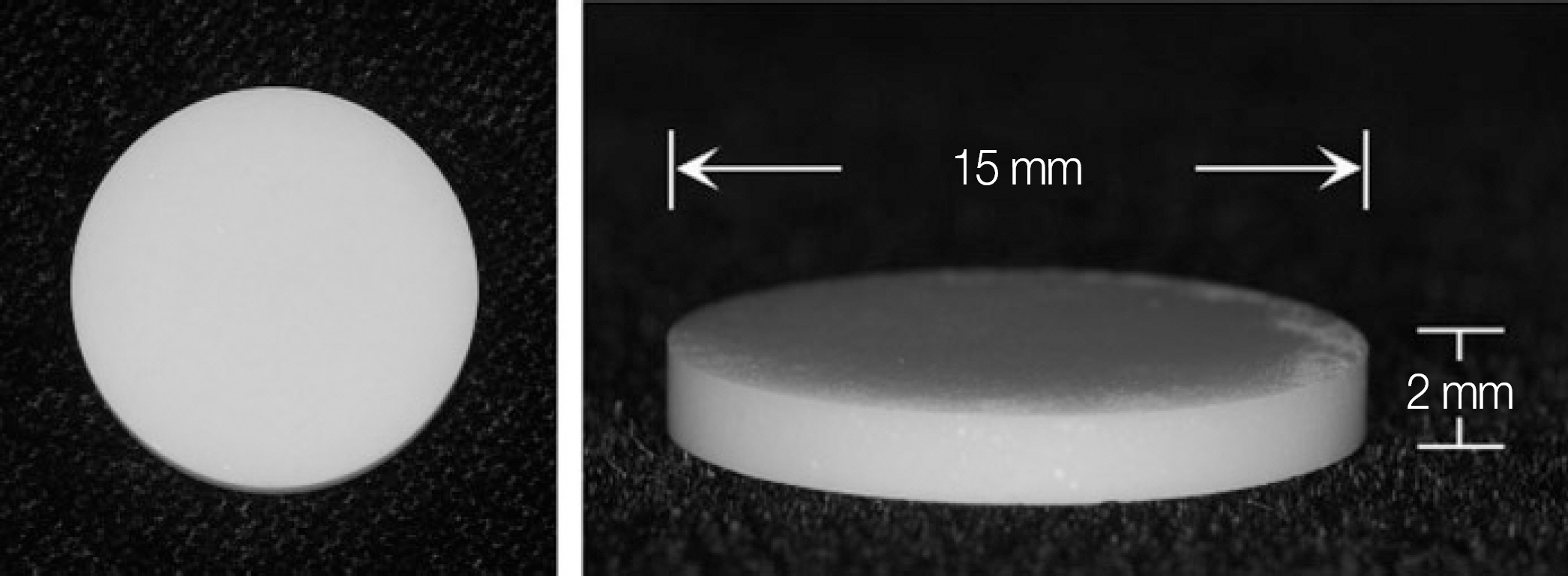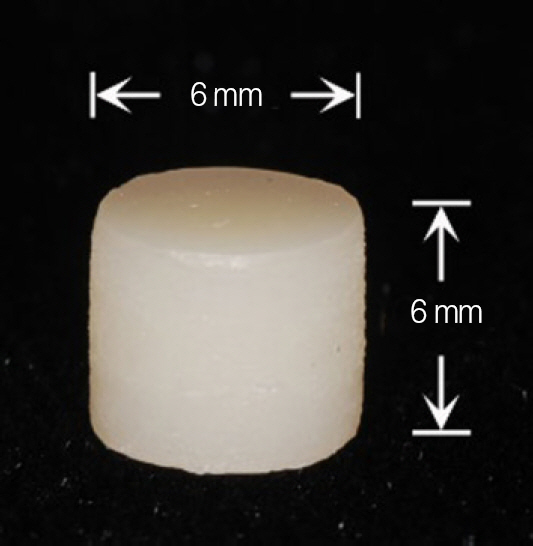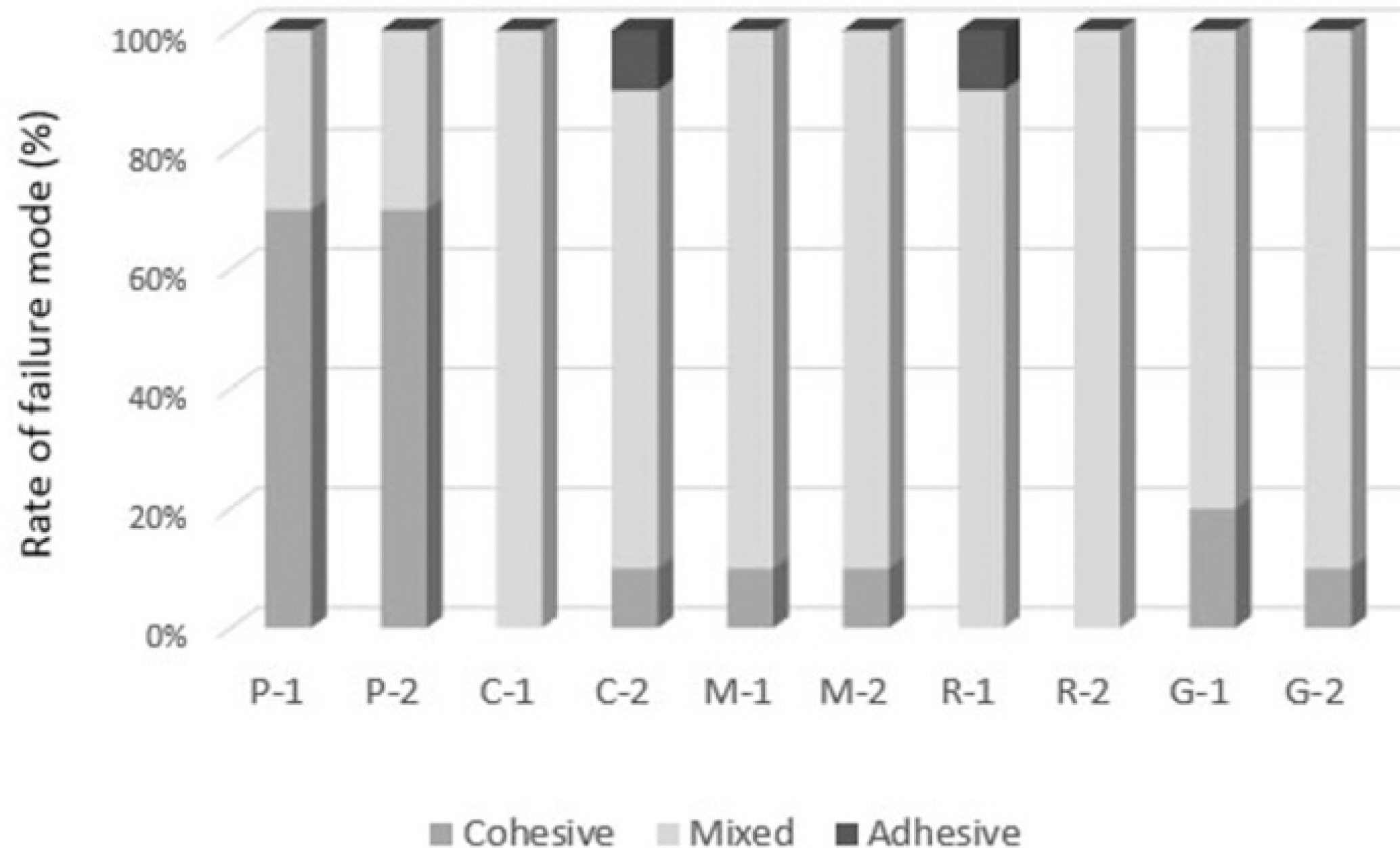J Korean Acad Prosthodont.
2015 Oct;53(4):318-324. 10.4047/jkap.2015.53.4.318.
Evaluation of shear-bond strength between different self-adhesive resin cements with phosphate monomer and zirconia ceramic before and after thermocycling
- Affiliations
-
- 1Department of Prosthodontics, School of Dentistry and Institute of Oral Bio-Science, Chonbuk National University, Jeonju, Republic of Korea. jmseo@jbnu.ac.kr
- KMID: 2118803
- DOI: http://doi.org/10.4047/jkap.2015.53.4.318
Abstract
- PURPOSE
This study compared shear bond strengths of five self-adhesive cements with phosphate monomer to zirconium oxide ceramic with and without airborn particle abrasion.
MATERIALS AND METHODS
One hundred zirconia samples were air-abraded (50 microm Al2O3). One hundred composite resin cylinders were fabricated. Composite cylinders were bonded to the zirconia samples with either Permacem 2.0 (P), Clearfil(TM) SA Luting (C), Multilink(R) Speed (M), RelyX(TM) U200 Automix (R), G-Cem LinkAce(TM) (G). All bonded specimens were stored in distilled water (37degrees C) for 24 h and half of them were additionally aged by thermocycling (5degrees C, 55degrees C, 5,000 times). The bonded specimens were loaded in shear force until fracture (1 mm/min) by using Universal Testing Machine (Model 4201, Instron Co, Canton, MA, USA). The failure sites were inspected under field-emission scanning electron microscopy. The data was analyzed with ANOVA, Tukey HSD post-hoc test and paired samples t-test (alpha=.05).
RESULTS
Before and after thermocycling, Multilink(R) Speed (M) revealed higher shear-bond strength than the other cements. G-Cem LinkAce(TM) (G) showed significantly lower bond strengths after thermocycling than before treatment (P<.05), but the other groups were not significantly different (P>.05).
CONCLUSION
Most self-adhesive cements with phosphate monomer showed high shear bond strength with zirconia ceramic and weren't influenced by thermocycling, so they seem to valuable to zirconia ceramic bonding.
Keyword
MeSH Terms
Figure
Reference
-
1. Anusavice KJ. Recent developments in restorative dental ceramics. J Am Dent Assoc. 1993; 124:72–4. 76-8. 80–4.
Article2. Kelly JR, Nishimura I, Campbell SD. Ceramics in dentistry: his-torical roots and current perspectives. J Prosthet Dent. 1996; 75:18–32.
Article3. Lin J, Shinya A, Gomi H, Shinya A. Effect of self-adhesive resin cement and tribochemical treatment on bond strength to zirconia. Int J Oral Sci. 2010; 2:28–34.
Article4. Luthardt RG, Sandkuhl O, Reitz B. Zirconia-TZP and alumina–advanced technologies for the manufacturing of single crowns. Eur J Prosthodont Restor Dent. 1999; 7:113–9.5. Passos SP, May LG, Barca DC, Ozcan M, Bottino MA, Valandro LF. Adhesive quality of self-adhesive and conventional adhesive resin cement to Y-TZP ceramic before and after aging conditions. Oper Dent. 2010; 35:689–96.
Article6. Derand T, Molin M, Kvam K. Bond strength of composite luting cement to zirconia ceramic surfaces. Dent Mater. 2005; 21:1158–62.
Article7. Anusavice KJ. Phillips science of dental materials. 11th ed.Saunders: Missouri, USA;2003. p. 443–94.8. Dixon DL, Breeding LC, Hughie ML, Brown JS. Comparison of shear bond strengths of two resin luting systems for a base and a high noble metal alloy bonded to enamel. J Prosthet Dent. 1994; 72:457–61.
Article9. In HS, Park JI, Choi JI, Cho HW, Dong JK. The study of shear bond strength of a self-adhesive resin luting cement to dentin. J Korean Acad Prosthodont. 2008; 46:535–43.
Article10. Miragaya L, Maia LC, Sabrosa CE, de Goes MF, da Silva EM. Evaluation of self-adhesive resin cement bond strength to yttria-stabilized zirconia ceramic (Y-TZP) using four surface treatments. J Adhes Dent. 2011; 13:473–80.11. Komine F, Kobayashi K, Saito A, Fushiki R, Koizumi H, Matsumura H. Shear bond strength between an indirect composite veneering material and zirconia ceramics after thermocycling. J Oral Sci. 2009; 51:629–34.
Article12. Ikemura K, Jogetsu Y, Shinno K, Nakatsuka T, Endo T, Kadoma Y. Effects of a newly designed HEMA-free, multi-purpose, single-bottle, self-etching adhesive on bonding to dental hard tis-sues, zirconia-based ceramics, and gold alloy. Dent Mater J. 2011; 30:616–25.
Article13. Kim AJ, Yu SH, Oh SH, Bae JM. Effect of self-adhesive resin cements on the shear bond strengths between bovine teeth and composite resin block. J Korean Soc Dent Mater. 2013; 40:367–72.14. Lü thy H, Loeffel O, Hammerle CH. Effect of thermocycling on bond strength of luting cements to zirconia ceramic. Dent Mater. 2006; 22:195–200.15. Wolfart M, Lehmann F, Wolfart S, Kern M. Durability of the resin bond strength to zirconia ceramic after using different surface conditioning methods. Dent Mater. 2007; 23:45–50.
Article16. Ferracane JL, Stansbury JW, Burke FJ. Self-adhesive resin cements - chemistry, properties and clinical considerations. J Oral Rehabil. 2011; 38:295–314.
Article17. Oyagü e RC, Monticelli F, Toledano M, Osorio E, Ferrari M, Osorio R. Effect of water aging on microtensile bond strength of dual-cured resin cements to pre-treated sintered zirconium-oxide ceramics. Dent Mater. 2009; 25:392–9.18. D'Amario M, Campidoglio M, Morresi AL, Luciani L, Marchetti E, Baldi M. Effect of thermocycling on the bond strength between dual-cured resin cements and zirconium-oxide ceramics. J Oral Sci. 2010; 52:425–30.19. Toledano M, Osorio R, Osorio E, Aguilera FS, Yamauti M, Pashley DH, Tay F. Durability of resin-dentin bonds: effects of direct/indirect exposure and storage media. Dent Mater. 2007; 23:885–92.
Article20. Fischer J, Grohmann P, Stawarczyk B. Effect of zirconia surface treatments on the shear strength of zirconia/veneering ceramic composites. Dent Mater J. 2008; 27:448–54.
Article21. Chung KH, Greener EH. Correlation between degree of conversion, filler concentration and mechanical properties of posterior composite resins. J Oral Rehabil. 1990; 17:487–94.
Article22. Asmussen E, Peutzfeldt A. Influence of UEDMA BisGMA and TEGDMA on selected mechanical properties of experimental resin composites. Dent Mater. 1998; 14:51–6.
Article23. Blatz MB, Sadan A, Martin J, Lang B. In vitro evaluation of shear bond strengths of resin to densely-sintered high-purity zirconi-um-oxide ceramic after long-term storage and thermal cycling. J Prosthet Dent. 2004; 91:356–62.
Article
- Full Text Links
- Actions
-
Cited
- CITED
-
- Close
- Share
- Similar articles
-
- Shear Bonding Strength of Three Cements Luted on Pediatric Zirconia Crowns and Dentin of Primary Teeth
- The effect of surface treatment conditioning on shear bond strength between zirconia and dental resin cements
- Effect of surface treatment methods on the shear bond strength of resin cement to zirconia ceramic
- Shear bond strength of the three different kinds of resin cement on CAD/CAM ceramic inlay
- Influence of nano-structured alumina coating treatment on shear bond strength between zirconia ceramic and resin cement







